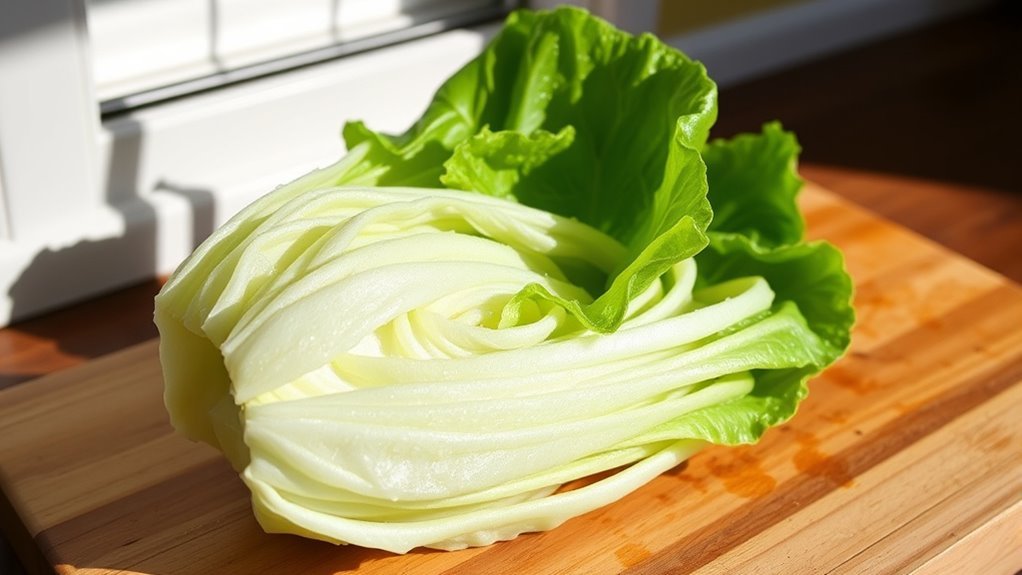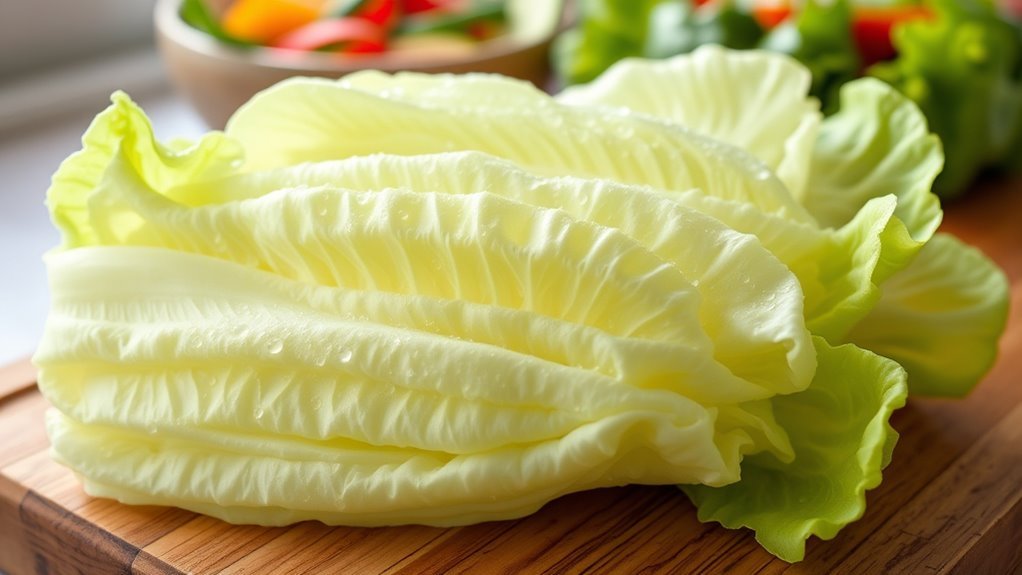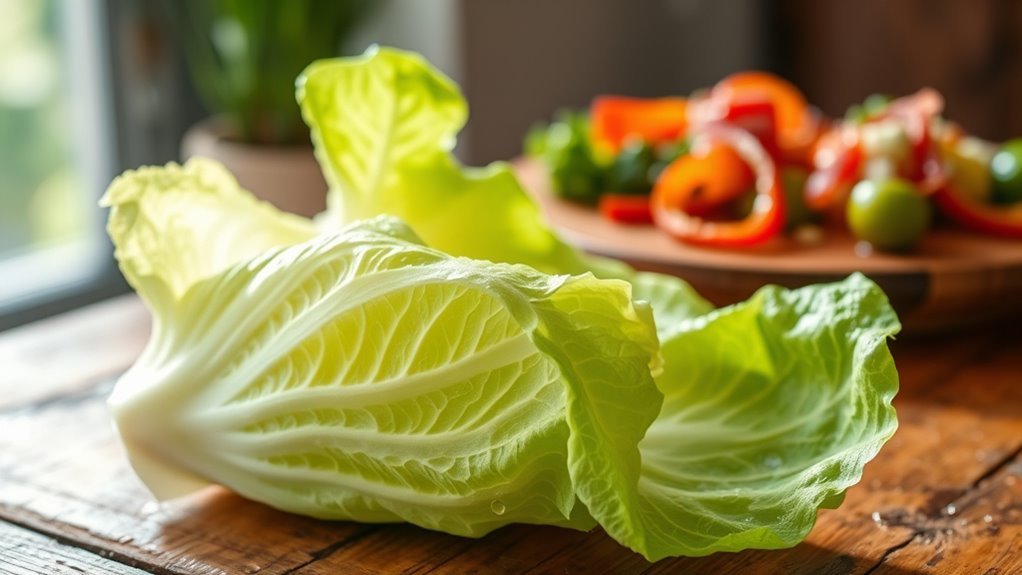Yes, iceberg lettuce is a keto-friendly option. It’s low in calories, with about 10 calories and 1 gram of net carbs per cup, making it great for maintaining ketosis. Its high water content (around 95%) helps keep you hydrated too. While it’s not as nutrient-dense as darker greens, it still offers some fiber and vitamin K. If you’re looking for creative ways to incorporate it into your meals, you’ll find plenty of delicious options to explore.
Nutritional Profile of Iceberg Lettuce

When considering the nutritional profile of iceberg lettuce, it’s essential to note its low calorie and carbohydrate content. This leafy green provides about 10 calories and 2 grams of carbs per serving, making it a popular choice for those seeking to manage their weight. One of the primary iceberg lettuce benefits is its hydrating properties, as it contains a high water content, which can support overall hydration. However, iceberg lettuce does have some drawbacks; it’s lower in vitamins and minerals compared to darker greens. While it offers some fiber, the nutritional density may not meet the needs of those seeking a nutrient-rich diet. Balancing iceberg lettuce with other leafy greens can contribute to a more varied and nourishing meal plan.
Carb Count: Is Iceberg Lettuce Low in Carbs?

How low in carbs is iceberg lettuce, and what does that mean for a keto diet? Iceberg lettuce contains about 1 gram of net carbs per cup, making it an excellent choice for those following a ketogenic lifestyle. In carb comparison with other leafy greens, it remains one of the lower-carb options, which is vital for maintaining ketosis. You can enjoy it in salads or as a crunchy wrap without greatly impacting your carb intake. This low-carb profile allows you to incorporate iceberg lettuce into various dishes, providing versatility while staying within your keto limits. So, if you’re seeking freedom in your meal choices while keeping carbs low, iceberg lettuce is a smart addition to your keto diet.
Benefits of Incorporating Iceberg Lettuce Into a Keto Diet

Incorporating iceberg lettuce into your keto diet offers several benefits, starting with its low carb content, which helps you stay within your daily limits. It also provides hydration, as lettuce is made up of about 95% water, making it a revitalizing choice. Additionally, its versatility allows you to use it in various dishes, enhancing your meals without adding significant carbs.
Low Carb Content
One of the standout features of iceberg lettuce is its impressively low carbohydrate content, making it an ideal addition to a keto diet. With only about 1 gram of net carbs per cup, you can enjoy this crunchy green without worrying about exceeding your carb limits. This low carb profile not only helps maintain ketosis but also encourages a healthy choice in your meals.
Here are some benefits of incorporating iceberg lettuce:
- Low calorie, allowing for guilt-free snacking.
- Provides fiber, aiding digestion.
- Versatile in salads, wraps, and sandwiches.
- Adds crunch and freshness to your dishes.
Hydration Benefits
Although you might not think of lettuce as a significant source of hydration, iceberg lettuce actually offers a revitalizing way to boost your fluid intake on a keto diet. With a water content of about 95%, it ranks among the top hydration sources in the vegetable kingdom. Staying hydrated is essential on keto, as the diet can lead to increased water loss. Incorporating iceberg lettuce into your meals not only helps combat dehydration but also enhances your overall well-being. You can enjoy its crisp texture in salads, wraps, or as a garnish, all while knowing you’re nourishing your body. So, next time you’re planning your meals, remember that this humble lettuce can play a key role in your hydration strategy.
Versatile Ingredient Options
While many vegetables can fit seamlessly into a keto diet, iceberg lettuce stands out for its remarkable versatility. You can easily incorporate it into your meals, allowing for a variety of flavors and textures without compromising your carb intake. Here are some innovative ways to enjoy iceberg lettuce:
- Salad variations: Use it as a base for invigorating salads, pairing it with low-carb veggies, proteins, and healthy fats.
- Wrap alternatives: Replace traditional wraps with iceberg leaves for tacos or sandwiches, keeping your meals light and keto-friendly.
- Crunchy toppings: Add chopped lettuce to soups or stir-fries for a satisfying crunch.
- Garnishes: Use it as a garnish for dishes, enhancing presentation and flavor.
Incorporating iceberg lettuce can elevate your keto experience while keeping things delicious and exciting.
Comparing Iceberg Lettuce to Other Leafy Greens
When you compare iceberg lettuce to other leafy greens, you’ll notice significant differences in nutritional value, flavor, and texture. While iceberg offers a crisp, mild taste, options like spinach and kale provide more vitamins and minerals, which can enhance your keto meal plans. Understanding these differences can help you make more informed choices about your greens.
Nutritional Value Comparison
Iceberg lettuce, often perceived as a low-nutrient option, actually holds its own when compared to other leafy greens like spinach and kale. While it may have lower nutritional density, it still offers some benefits worth noting:
- Contains about 5 calories per cup, making it a great low-calorie base.
- Provides a decent amount of hydration due to its high water content (over 95%).
- Offers some vitamins, including vitamin K, which is essential for bone health.
- Has a crunch that many enjoy, serving as a satisfying foundation for salads.
While it may not match the vitamin content of kale or spinach, iceberg lettuce can still fit into a balanced diet, especially if you’re seeking something light and invigorating.
Flavor and Texture Differences
Although often overlooked, the flavor and texture of iceberg lettuce set it apart from other leafy greens. Its signature crunchy texture makes it a revitalizing choice for salads and wraps, providing a satisfying bite that contrasts with softer greens like spinach or arugula. While these alternatives offer bolder, peppery flavors, iceberg lettuce boasts a mild flavor that complements rather than competes with dressings and toppings. This can be particularly appealing if you’re aiming for a balanced dish without overpowering taste. Additionally, when you crave a light, crisp element in your meal, iceberg lettuce delivers just that. In the domain of keto, its low carb count and hydrating nature make it a versatile ingredient, allowing you to enjoy your meals freely.
Creative Ways to Use Iceberg Lettuce in Keto Meals
While many might overlook iceberg lettuce in favor of more nutrient-dense greens, it can actually play a versatile role in your keto meals. Its crisp texture and mild flavor make it a fantastic base for various dishes. Here are some creative uses for iceberg lettuce:
- Lettuce wraps: Swap out tortillas for crisp lettuce leaves filled with grilled chicken, avocado, and cheese.
- Salad bowls: Use chopped iceberg as a base for a hearty salad topped with high-fat ingredients like olives and feta.
- Taco boats: Fill iceberg leaves with seasoned ground beef or turkey for a keto-friendly taco experience.
- Crunchy side dish: Pair iceberg wedges with a rich, creamy dressing for an invigorating side.
These ideas let you enjoy the benefits of iceberg lettuce while staying on track with your keto lifestyle.
Potential Drawbacks of Eating Iceberg Lettuce on Keto
When considering iceberg lettuce as a staple in your keto diet, it’s important to weigh its limitations alongside its benefits. One significant drawback is its low caloric density; while it offers minimal calories, it also provides very little nutrition compared to other leafy greens. This can lead to a lack of essential vitamins and minerals in your meals. Additionally, iceberg lettuce has a low fiber content, which may not support digestive health as effectively as other vegetables, potentially leaving you feeling less satiated. If you rely heavily on iceberg lettuce, you might miss out on the nutritional diversity needed for a balanced keto lifestyle. Balance is key; incorporating a variety of vegetables can guarantee you’re meeting your dietary needs.
Frequently Asked Questions
Can Iceberg Lettuce Be Grown in a Home Garden?
Yes, you can definitely grow iceberg lettuce in a home garden! For success, make sure you provide the right growing conditions, like well-draining soil and plenty of sunlight. Plant seeds in early spring or fall for ideal growth. Remember to keep the soil consistently moist, but not soggy. Utilizing home garden tips, like spacing plants adequately and using organic fertilizers, can enhance your yield and guarantee a fresh, crispy harvest right from your backyard.
How Should Iceberg Lettuce Be Stored for Freshness?
Storing iceberg lettuce is like keeping a treasure safe; you’ve gotta protect it from wilting. For ideal freshness, wrap the lettuce in a damp paper towel and place it in a breathable storage container. Refrigeration tips suggest keeping it in the crisper drawer, where humidity levels are just right. Avoid washing it until you’re ready to eat, as excess moisture can lead to spoilage. With these methods, you’ll enjoy crisp lettuce for longer!
Does Iceberg Lettuce Have Any Vitamins or Minerals?
Iceberg lettuce does have some nutritional benefits, though it’s often considered less nutrient-dense than other greens. It contains small amounts of vitamins A and K, along with folate and some minerals like potassium. While its vitamin content isn’t extensive, it can still contribute to your daily intake. If you’re looking for variety, combining it with other leafy greens can enhance the overall nutritional profile of your meals.
Can Iceberg Lettuce Be Eaten Raw or Cooked?
You can enjoy iceberg lettuce in both raw consumption and cooked options. Eating it raw in salads or as a crunchy topping offers a revitalizing flavor and retains its crisp texture. On the other hand, cooking it—like sautéing or grilling—can soften its leaves while enhancing its mild taste. Both methods provide versatility in your meals, allowing you to incorporate iceberg lettuce in various dishes while enjoying its unique qualities.
What Are the Best Dressings for Iceberg Lettuce Salads?
When you’re making an iceberg lettuce salad, choosing the right salad dressings is essential. For low carb options, consider vinaigrettes made with olive oil and vinegar, or creamy dressings like ranch made with Greek yogurt. These choices not only enhance flavor but also keep your carb count in check. Always check labels for hidden sugars, ensuring your salad remains both delicious and aligned with your dietary goals. Enjoy the freedom of flavor without compromising!


